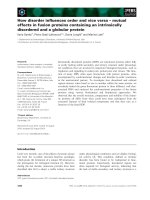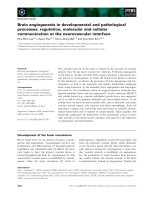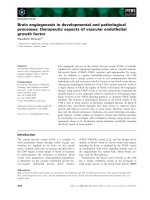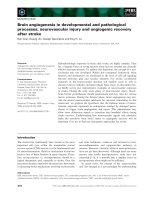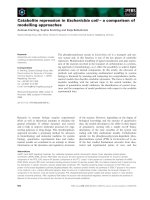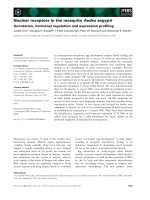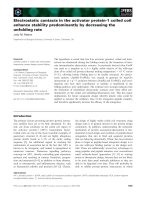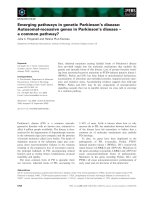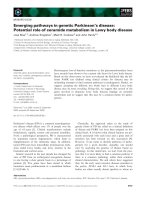Báo cáo khoa học: "Capturing Errors in Written Chinese Words" docx
Bạn đang xem bản rút gọn của tài liệu. Xem và tải ngay bản đầy đủ của tài liệu tại đây (118.69 KB, 4 trang )
Proceedings of the ACL-IJCNLP 2009 Conference Short Papers, pages 25–28,
Suntec, Singapore, 4 August 2009.
c
2009 ACL and AFNLP
Capturing Errors in Written Chinese Words
Chao-Lin Liu
1
Kan-Wen Tien
2
Min-Hua Lai
3
Yi-Hsuan Chuang
4
Shih-Hung Wu
5
1-4
National Chengchi University,
5
Chaoyang University of Technology, Taiwan
{
1
chaolin,
2
96753027,
3
95753023,
4
94703036}@nccu.edu.tw,
5
Abstract
A collection of 3208 reported errors of Chinese
words were analyzed. Among which, 7.2% in-
volved rarely used character, and 98.4% were
assigned common classifications of their causes
by human subjects. In particular, 80% of the er-
rors observed in writings of middle school stu-
dents were related to the pronunciations and
30% were related to the compositions of words.
Experimental results show that using intuitive
Web-based statistics helped us capture only
about 75% of these errors. In a related task, the
Web-based statistics are useful for recommend-
ing incorrect characters for composing test items
for "incorrect character identification" tests
about 93% of the time.
1 Introduction
Incorrect writings in Chinese are related to our under-
standing of the cognitive process of reading Chinese
(e.g., Leck et al., 1995), to our understanding of why
people produce incorrect characters and our offering
corresponding remedies (e.g., Law et al., 2005), and
to building an environment for assisting the prepara-
tion of test items for assessing students’ knowledge of
Chinese characters (e.g., Liu and Lin, 2008).
Chinese characters are composed of smaller parts
that can carry phonological and/or semantic informa-
tion. A Chinese word is formed by Chinese characters.
For example, 新加坡 (Singapore) is a word that con-
tains three Chinese characters. The left (土) and the
right (皮) part of 坡, respectively, carry semantic and
phonological information. Evidences show that pro-
duction of incorrect characters are related to either
phonological or the semantic aspect of the characters.
In this study, we investigate several issues that are
related to incorrect characters in Chinese words. In
Section 2, we present the sources of the reported er-
rors. In Section 3, we analyze the causes of the ob-
served errors. In Section 4, we explore the effective-
ness of relying on Web-based statistics to correct the
errors. The current results are encouraging but de-
mand further improvements. In Section 5, we employ
Web-based statistics in the process of assisting teach-
ers to prepare test items for assessing students’
knowledge of Chinese characters. Experimental re-
sults showed that our method outperformed the one
reported in (Liu and Lin, 2008), and captured the best
candidates for incorrect characters 93% of the time.
2 Data Sources
We obtained data from three major sources. A list that
contains 5401 characters that have been believed to be
sufficient for everyday lives was obtained from the
Ministry of Education (MOE) of Taiwan, and we call
the first list the Clist, henceforth. We have two lists of
words, and each word is accompanied by an incorrect
way to write certain words. The first list is from a
book published by MOE (MOE, 1996). The MOE
provided the correct words and specified the incorrect
characters which were mistakenly
used to replace the
correct characters in the correct words. The second
list was collected, in 2008, from the written essays of
students of the seventh and the eighth grades in a
middle school in Taipei. The incorrect words were
entered into computers based on students’ writings,
ignoring those characters that did not actually exist
and could not be entered.
We will call the first list of incorrect words the
Elist, and the second the Jlist from now on. Elist and
Jlist contain, respectively, 1490 and 1718 entries.
Each of these entries contains a correct word and the
incorrect character. Hence, we can reconstruct the
incorrect words easily. Two or more different ways to
incorrectly write the same words were listed in differ-
ent entries and considered as two entries for simplic-
ity of presentation.
3 Error Analysis of Written Words
Two subjects, who are native speakers of Chinese and
are graduate students in Computer Science, examined
Elist and Jlist and categorized the causes of errors.
They compared the incorrect characters with the cor-
rect characters to determine whether the errors were
pronunciation-related or semantic-related. Referring
to an error as being “semantic-related” is ambiguous.
Two characters might not contain the same semantic
part, but are still semantically related. In this study,
we have not considered this factor. For this reason we
refer to the errors that are related to the sharing of
semantic parts in characters as composition-related.
It is interesting to learn that native speakers had a
high consensus about the causes for the observed er-
rors, but they did not always agree. Hence, we studied
the errors that the two subjects had agreed categoriza-
tions. Among the 1490 and 1718 words in Elist and
Jlist, respectively, the two human subjects had con-
sensus over causes of 1441 and 1583 errors.
The statistics changed when we disregarded errors
that involved characters not included in Clist. An er-
ror would be ignored if either the correct or the incor-
rect character did not belong to the Clist. It is possible
for students to write such rarely used characters in an
incorrect word just by coincidence.
After ignoring the rare characters, there were 1333
and 1645 words in Elist and Jlist, respectively. The
subjects had consensus over the categories for 1285
25
and 1515 errors in Elist and Jlist, respectively.
Table 1 shows the percentages of five categories of
errors: C for the composition-related errors, P for the
pronunciation-related errors, C&P for the intersection
of C and P, NE for those errors that belonged to nei-
ther C nor P, and D for those errors that the subjects
disagreed on the error categories. There were, respec-
tively, 505 composition-related and 1314 pronuncia-
tion-related errors in Jlist, so we see 30.70%
(=505/1645) and 79.88% (=1314/1645) in the table.
Notice that C&P represents the intersection of C and
P, so we have to deduct C&P from the sum of C, P,
NE, and D to find the total probability, namely 1.
It is worthwhile to discuss the implication of the
statistics in Table 1. For the Jlist, similarity between
pronunciations accounted for nearly 80% of the errors,
and the ratio for the errors that are related to composi-
tions and pronunciations is 1:2.6. In contrast, for the
Elist, the corresponding ratio is almost 1:1. The Jlist
and Elist differed significantly in the ratios of the er-
ror types. It was assumed that the dominance of pro-
nunciation-related errors in electronic documents was
a result of the popularity of entering Chinese with
pronunciation-based methods. The ratio for the Jlist
challenges this popular belief, and indicates that even
though the errors occurred during a writing process,
rather than typing on computers, students still pro-
duced more pronunciation-related errors than compo-
sition-related errors. Distribution over error types is
not as related to input method as one may have be-
lieved. Nevertheless, the observation might still be a
result of students being so used to entering Chinese
text with pronunciation-based method that the organi-
zation of their mental lexicons is also pronunciation
related. The ratio for the Elist suggests that editors of
the MOE book may have chosen the examples with a
special viewpoint in their minds – balancing the errors
due to pronunciation and composition.
4 Reliability of Web-based Statistics
In this section, we examine the effectiveness of using
Web-based statistics to differentiate correct and incor-
rect characters. The abundant text material on the
Internet gives people to treat the Web as a corpus (e.g.,
webascorpus.org). When we send a query to Google,
we will be informed of the number of pages (NOPs)
that possibly contain relevant information. If we put
the query terms in quotation marks, we should find
the web pages that literally contain the query terms.
Hence, it is possible for us to compare the NOPs for
two competing phrases for guessing the correct way
of writing. At the time of this writing, Google found
107000 and 3220 pages, respectively, for “strong tea”
and “powerful tea”. (When conducting such advanced
searches with Google, the quotation marks are needed
to ensure the adjacency of individual words.) Hence,
“strong” appears to be a better choice to go with “tea”.
How does this strategy serve for learners of Chinese?
We verified this strategy by sending the words in
both the Elist and the Jlist to Google to find the NOPs.
We can retrieve the NOPs from the documents re-
turned by Google, and compare the NOPs for the cor-
rect and the incorrect words to evaluate the strategy.
Again, we focused on those in the 5401 words that the
human subjects had consensus about their error types.
Recall that we have 1285 and 1515 such words in
Elist and Jlist, respectively. As the information avail-
able on the Web changes all the time, we also have to
note that our experiments were conducted during the
first half of March 2009. The queries were submitted
at reasonable time intervals to avoid Google’s treating
our programs as malicious attackers.
Table 2 shows the results of our investigation. We
considered that we had a correct result when we found
that the NOP for the correct word larger than the NOP
for the incorrect word. If the NOPs were equal, we
recorded an ambiguous result; and when the NOP for
the incorrect word is larger, we recorded an incorrect
event. We use ‘C’, ‘A’, and ‘I’ to denote “correct”,
“ambiguous”, and “incorrect” events in Table 2.
The column headings of Table 2 show the setting
of the searches with Google and the set of words that
were used in the experiments. We asked Google to
look for information from web pages that were en-
coded in traditional Chinese (denoted Trad). We
could add another restriction on the source of infor-
mation by asking Google to inspect web pages from
machines in Taiwan (denoted Twn+Trad). We were
not sure how Google determined the languages and
locations of the information sources, but chose to trust
Google. The headings “Comp” and “Pron” indicate
whether the words whose error types were composi-
tion and pronunciation-related, respectively.
Table 2 shows eight distributions, providing ex-
perimental results that we observed under different
settings. The distribution printed in bold face showed
that, when we gathered information from sources that
were encoded in traditional Chinese, we found the
correct words 73.12% of the time for words whose
error types were related to composition in Elist. Under
the same experimental setting, we could not judge the
correct word 4.58% of the time, and would have cho-
sen an incorrect word 22.30% of the time.
Statistics in Table 2 indicate that web statistics is
not a very reliable factor to judge the correct words.
The average of the eight numbers in the ‘C’ rows is
only 71.54% and the best sample is 76.59%, suggest-
Table 2. Reliability of Web-based statistics
Trad Twn+Trad
Comp Pron Comp Pron
C 73.12% 73.80% 69.92% 68.72%
A 4.58% 3.76% 3.83% 3.76%
Elist
I 22.30% 22.44% 26.25% 27.52%
C 76.59% 74.98% 69.34% 65.87%
A 2.26% 3.97% 2.47% 5.01%
Jlist
I 21.15% 21.05% 28.19% 29.12%
Table 1. Error analysis for Elist and Jlist
C P C&P NE D
Elist 66.09% 67.21% 37.13% 0.23% 3.60%
Jlist 30.70% 79.88% 20.91% 2.43% 7.90%
26
ing that we did not find the correct words frequently.
We would made incorrect judgments 24.75% of the
time. The statistics also show that it is almost equally
difficult to find correct words for errors that are com-
position and pronunciation related. In addition, the
statistics reveal that choosing more features in the
advanced search affected the final results. Using
“Trad” offered better results in our experiments than
using “Twn+Trad”. This observation may arouse a
perhaps controversial argument. Although Taiwan has
proclaimed to be the major region to use traditional
Chinese, their web pages might not have used as ac-
curate Chinese as web pages located in other regions.
We have analyzed the reasons for why using Web-
based statistics did not find the correct words. Fre-
quencies might not have been a good factor to deter-
mine the correctness of Chinese. However, the myriad
amount of data on the Web should have provided a
better performance. Google’s rephrasing our submit-
ted queries is an important factor, and, in other cases,
incorrect words were more commonly used.
5 Facilitating Test Item Authoring
Incorrect character correction is a very popular type of
test in Taiwan. There are simple test items for young
children, and there are very challenging test items for
the competitions among adults. Finding an attractive
incorrect character to replace a correct character to
form a test item is a key step in authoring test items.
We have been trying to build a software environ-
ment for assisting the authoring of test items for in-
correct character correction (Liu and Lin, 2008, Liu et
al., 2009). It should be easy to find a lexicon that con-
tains pronunciation information about Chinese charac-
ters. In contrast, it might not be easy to find visually
similar Chinese characters with computational meth-
ods. We expanded the original Cangjie codes (OCC),
and employed the expanded Cangjie codes (ECC) to
find visually similar characters (Liu and Lin, 2008).
With a lexicon, we can find characters that can be
pronounced in a particular way. However, this is not
enough for our goal. We observed that there were
different symptoms when people used incorrect char-
acters that are related to their pronunciations. They
may use characters that could be pronounced exactly
the same as the correct characters. They may also use
characters that have the same pronunciation and dif-
ferent tones with the correct character. Although rela-
tively infrequently, people may use characters whose
pronunciations are similar to but different from the
pronunciation of the correct character.
As Liu and Lin (2008) reported, replacing OCC
with ECC to find visually similar characters could
increase the chances to find similar characters. Yet, it
was not clear as to which components of a character
should use ECC.
5.1 Formalizing the Extended Cangjie Codes
We analyzed the OCCs for all the words in Clist to
determine the list of basic components. We treated a
Cangjie basic symbol as if it was a word, and com-
puted the number of occurrences of n-grams based on
the OCCs of the words in Clist. Since the OCC for a
character contains at most five symbols, the longest n-
grams are 5-grams. Because the reason to use ECC
was to find common components in characters, we
disregarded n-grams that repeated no more than three
times. In addition, the n-grams that appeared more
than three times might not represent an actual compo-
nent in Chinese characters. Hence, we also removed
such n-grams from the list of our basic components.
This process naturally made our list include radicals
that are used to categorize Chinese characters in typi-
cal printed dictionaries. The current list contains 794
components, and it is possible to revise the list of ba-
sic components in our work whenever necessary.
After selecting the list of basic components with
the above procedure, we encoded the words in Elist
with our list of basic components. We adopted the 12
ways that Liu and Lin (2008) employed to decompose
Chinese characters. There are other methods for de-
composing Chinese characters into components.
Juang et al. (2005) and the research team at the Sinica
Academia propose 13 different ways for decomposing
characters.
5.2 Recommending Incorrect Alternatives
With a dictionary that provides the pronunciation of
Chinese characters and the improved ECC encodings
for words in the Elist, we can create lists of candidate
characters for replacing a specific correct character in
a given word to create a test item for incorrect charac-
ter correction.
There are multiple strategies to create the candidate
lists. We may propose the candidate characters be-
cause their pronunciations have the s
ame sound and
the same tone with those of the correct character (de-
noted SSST). Characters that have same sounds and
d
ifferent tones (SSDT), characters that have similar
s
ounds and same tones (MSST), and characters that
have sim
ilar sounds and different tones (MSDT) can
be considered as candidates as well. It is easy to judge
whether two Chinese characters have the same tone.
In contrast, it is not trivial to define “similar” sound.
We adopted the list of similar sounds that was pro-
vided by a psycholinguistic researcher (Dr. Chia-Ying
Lee) at the Sinica Academia.
In addition, we may propose characters that look
similar to the correct character. Two characters may
look similar for two reasons. They may contain the
same components, or they contain the same r
adical
and have the same total number of strokes (RS).
When two characters contain the same component, the
shared component might or might not locate at the
same position within the bounding boxes of characters.
In an authoring tool, we could recommend a lim-
ited number of candidate characters for replacing the
correct character. We tried two strategies to compare
and choose the visually similar characters. The first
strategy (denoted SC1) gave a higher score to the
shared component that located at the same location in
the two characters being compared. The second strat-
27
egy (SC2) gave the same score to any shared compo-
nent even if the component did not reside at the same
location in the characters. When there were more than
20 characters that receive nonzero scores, we chose to
select at most 20 characters that had leading scores as
the list of recommended characters.
5.3 Evaluating the Recommendations
We examined the usefulness of these seven categories
of candidates with errors in Elist and Jlist. The first
set of evaluation (the inclusion tests) checked only
whether the lists of recommended characters con-
tained the incorrect character in our records. The sec-
ond set of evaluation (the ranking tests) was designed
for practical application in computer assisted item
generation. Only for those words whose actual incor-
rect characters were included in the recommended list,
we replaced the correct characters in the words with
the candidate incorrect characters, submitted the in-
correct words to Google, and ordered the candidate
characters based on their NOPs. We then recorded the
ranks of the incorrect characters among all recom-
mended characters.
Since the same character may appear simultane-
ously in SC1, SC2, and RS, we computed the union of
these three sets, and checked whether the incorrect
characters were in the union. The inclusion rate is
listed under Comp. Similarly, we computed the union
for SSST, SSDT, MSST, and MSDT, checked whether
the incorrect characters were in the union, and re-
corded the inclusion rate under Pron. Finally, we
computed the union of the lists created by the seven
strategies, and recorded the inclusion rate under Both.
The second and the third rows of Table 3 show the
results of the inclusion tests. The data show the per-
centage of the incorrect characters being included in
the lists that were recommended by the seven strate-
gies. Notice that the percentages were calculated with
different denominators. The number of composition-
related errors was used for SC1, SC2, RS, and Comp
(e.g. 505 that we mentioned in Section 3 for the Jlist);
the number of pronunciation-related errors for SSST,
SSDT, MSST, MSDT, and Pron (e.g., 1314 mentioned
in Section 3 for the Jlist); the number of either of
these two errors for Both (e.g., 1475 for Jlist).
The results recorded in Table 3 show that we were
able to find the incorrect character quite effectively,
achieving better than 93% for both Elist and Jlist. The
statistics also show that it is easier to find incorrect
characters that were used for pronunciation-related
problems. Most of the pronunciation-related problems
were misuses of characters that had exactly the same
pronunciations with the correct characters. Unex-
pected confusions, e.g., those related to pronuncia-
tions in Chinese dialects, were the main for the failure
to capture the pronunciation-related errors. SSDT is a
crucial complement to SSST. There is still room to
improve our methods to find confusing characters
based on their compositions. We inspected the list
generated by SC1 and SC2, and found that, although
SC2 outperformed SC1 on the inclusion rate, SC1 and
SC2 actually generated complementary lists and
should be used together. The inclusion rate achieved
by the RS strategy was surprisingly high.
The fourth and the fifth rows of Table 3 show the
effectiveness of relying on Google to rank the candi-
date characters for recommending an incorrect charac-
ter. The rows show the average ranks of the included
cases. The statistics show that, with the help of
Google, we were able to put the incorrect character on
top of the recommended list when the incorrect char-
acter was included. This allows us to build an envi-
ronment for assisting human teachers to efficiently
prepare test items for incorrect character identification.
6 Summary
The analysis of the 1718 errors produced by real stu-
dents show that similarity between pronunciations of
competing characters contributed most to the ob-
served errors. Evidences show that the Web statistics
are not very reliable for differentiating correct and
incorrect characters. In contrast, the Web statistics are
good for comparing the attractiveness of incorrect
characters for computer assisted item authoring.
Acknowledgements
This research has been funded in part by the National
Science Council of Taiwan under the grant
NSC-97-
2221-E-004-007-MY2
. We thank the anonymous re-
viewers for invaluable comments, and more responses
to the comments are available in (Liu et al. 2009).
References
D. Juang, J H. Wang, C Y. Lai, C C. Hsieh, L F. Chien,
J M. Ho. 2005. Resolving the unencoded character
problem for Chinese digital libraries, Proc. of the 5
th
ACM/IEEE Joint Conf. on Digital Libraries, 311–319.
S P. Law, W. Wong, K. M. Y. Chiu. 2005. Whole-word
phonological representations of disyllabic words in the
Chinese lexicon: Data from acquired dyslexia, Behav-
ioural Neurology, 16, 169–177.
K. J. Leck, B. S. Weekes, M. J. Chen. 1995. Visual and
phonological pathways to the lexicon: Evidence from
Chinese readers, Memory & Cognition, 23(4), 468–476.
C L. Liu et al. 2009. Phonological and logographic influ-
ences on errors in written Chinese words, Proc. of the 7
th
Workshop on Asian Language Resources, 47
th
ACL.
C L. Liu, J H. Lin. 2008. Using structural information for
identifying similar Chinese characters, Proc. of the 46th
ACL, short papers, 93‒96.
MOE. 1996. Common Errors in Chinese Writings (常用國
字辨似), Ministry of Education, Taiwan.
Table 3. Incorrect characters were contained and ranked high in the recommended lists
SC1 SC2 RS SSST SSDT MSST MSDT Comp Pron Both
Elist 73.92% 76.08% 4.08% 91.64% 18.39% 3.01% 1.67% 81.97% 99.00% 93.37%
Jlist 67.52% 74.65% 6.14% 92.16% 20.24% 4.19% 3.58% 77.62% 99.32% 97.29%
Elist 3.25 2.91 1.89 2.30 1.85 2.00 1.58
Jlist 2.82 2.64 2.19 3.72 2.24 2.77 1.16
28

